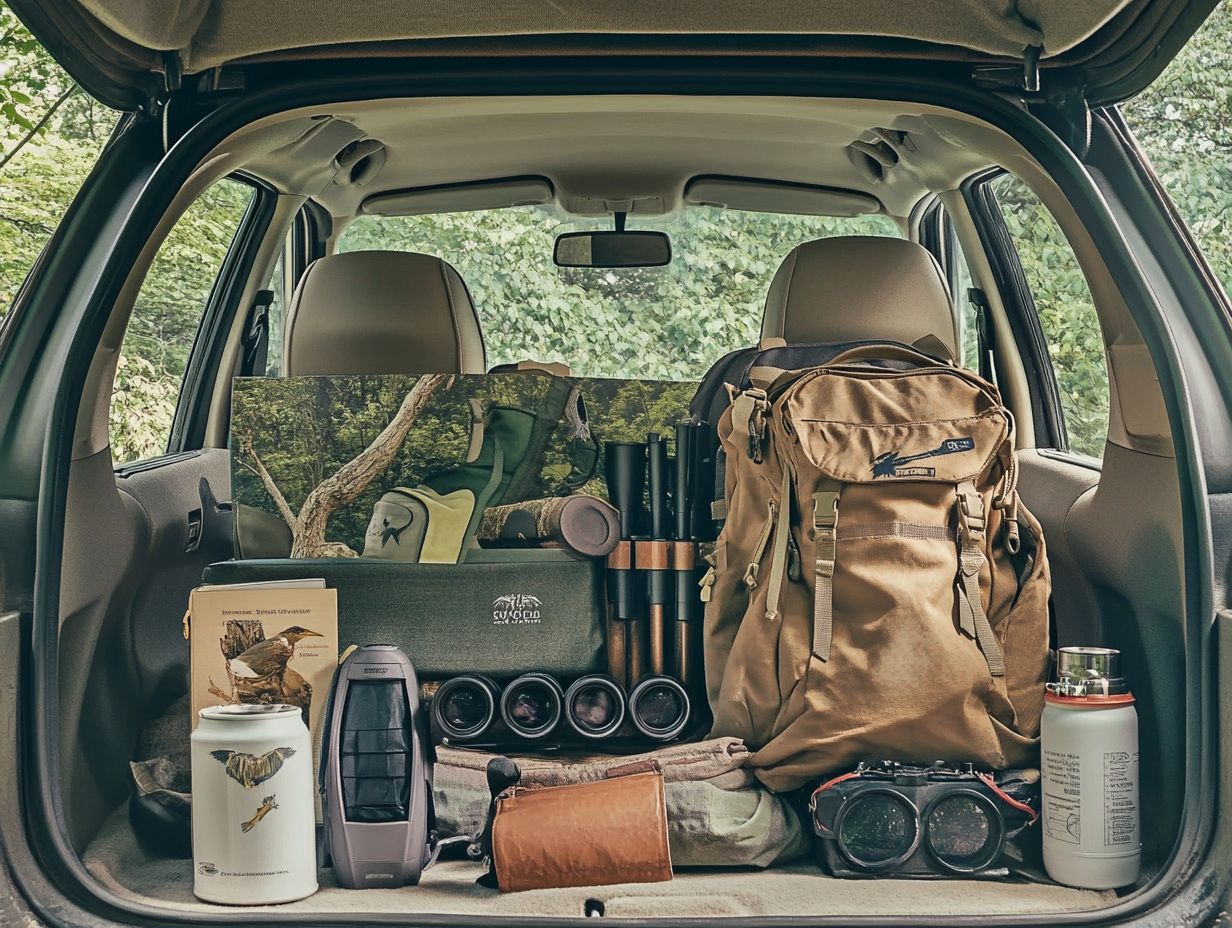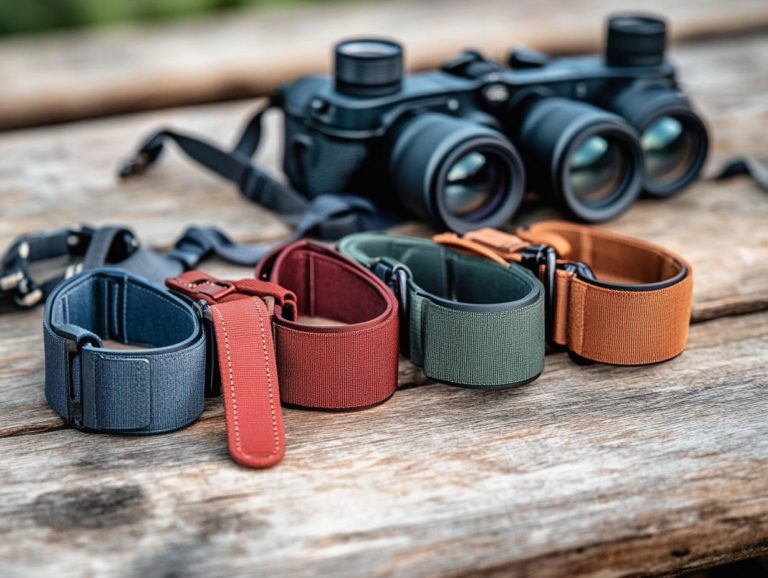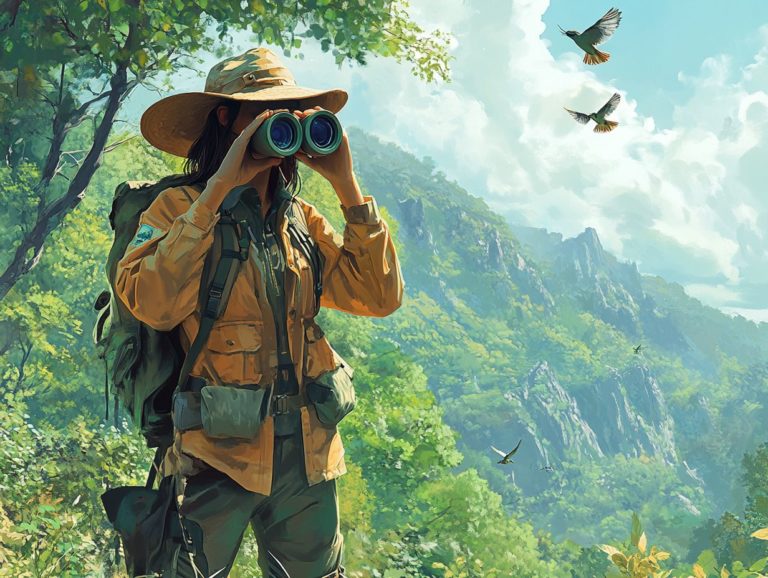Bird Watching Gear: What to Keep in Your Car
Bird watching, or birding, is an enchanting pastime that beautifully marries a passion for nature with the excitement of discovery.
Whether you re a seasoned birdwatching expert or a newcomer eager to explore, having the right gear at your fingertips can truly transform your experience. This article delves into essential equipment to keep in your car, covering everything from binoculars and field guides to handy notebooks, cameras, and hiking shoes.
It also highlights optional gear for those looking to elevate their adventures, along with expert tips for organizing everything efficiently. Prepare yourself to take your bird-watching experiences to new heights with the right tools, gear recommendations, and strategies!
Contents
- Key Takeaways:
- Essential Bird Watching Gear for Your Car
- Optional Gear for Your Car
- Tips for Organizing and Storing Your Gear
- Additional Considerations for Bird Watching Trips
- Frequently Asked Questions
- What are some essential items to keep in my car for bird watching?
- Do I need to invest in expensive binoculars for bird watching?
- What type of camera is best for capturing bird sightings?
- Why should I bring a notepad and pencil for bird watching?
- How can I protect my bird watching gear while keeping it in my car?
- Is it important to bring insect repellent for bird watching?
Key Takeaways:

- Always keep a pair of binoculars, a field guide, and a notebook and pen in your car for impromptu birdwatching opportunities.
- Think about getting extra gear like a spotting scope, tripod, field bag, bird feeders, and snacks and water for a comfortable experience.
- Organize and store your gear so it’s easily accessible and protected; adjust your gear based on the environment where you’ll be birdwatching.
Essential Bird Watching Gear for Your Car
Bird-watching enthusiasts like you understand that having the right gear in your car can transform your birding experience. Important tools like good binoculars and a dependable field guide, such as the Audubon Bird Guide or Kaufman Field Guide, are crucial for identifying various species. Additionally, consider investing in must-have bird watching gear to enhance your outings throughout the year.
Packing snacks like trail mix will keep you energized during those extended outings. With the right gear recommendations and identification apps like Merlin Bird ID, you can maximize your birding adventures, whether you re visiting a local park or gearing up for larger events like the Great Backyard Bird Count from February 16 to 19, 2024.
Binoculars
Binoculars are critical for your bird-watching adventures. They let you observe birds in stunning detail from afar, enriching your overall experience.
You ll find different types of binoculars tailored to meet various needs and preferences. Esteemed brands like Leica, Nikon, Maven C.2, and Celestron offer high-quality choices. For example, Leica s premium models are renowned for their exceptional clarity and light-gathering capabilities crucial for low-light moments at dawn or dusk.
Nikon strikes a remarkable balance between affordability and quality, making them a go-to for both novice and experienced birders. Meanwhile, Maven C.2 offers customizable configurations that cater to a range of birding styles.
When selecting binoculars, consider factors like magnification (how close you can see objects), typically between 8x and 10x, and lens size, which significantly impacts brightness. Brands such as Leica, Nikon, and Maven C.2 provide great options.
Regular maintenance, like using a lens cloth, storing them in a protective case, and keeping them away from extreme temperatures, can greatly extend their lifespan and ensure a crisp and enjoyable viewing experience.
Field Guide
A quality field guide is critical for your bird-watching adventures. It offers essential information that helps you identify various species, enriching your overall experience with resources from the Cornell Lab of Ornithology.
Investing in renowned titles like the Sibley Birds and the Kaufman Field Guide, along with Tim Gallagher’s The Grail Bird, can significantly elevate your observational skills. These guides are filled with stunning illustrations, useful range maps, and succinct descriptions that cater to everyone, from beginners to seasoned birders.
To make the most of them, take some time to familiarize yourself with their layout before you head into the field. You might even consider honing your identification techniques in your backyard or local park to boost your confidence.
Focusing on details such as plumage, song, and behavior can greatly enhance your ability to identify birds, turning each outing into a more enriching and rewarding experience.
Notebook and Pen
Bringing along a notebook and pen for your bird-watching excursions is an often-overlooked yet invaluable practice. It allows you to document your sightings and observations in a meaningful way.
By taking a moment to jot down details during events like the Great Backyard Bird Count, you can create a rich tapestry of data. This enhances your understanding and appreciation of local avian species and contributes to community science initiatives.
Your journal is your personal guide. It helps you spot patterns in migration, nesting behaviors, and seasonal appearances.
While you re out bird-watching, it s wise to note the date, time, weather conditions, and specific locations where you spot each bird. Include their physical descriptions and unique behaviors as well. Such meticulous records not only enrich your personal experience but also contribute significantly to broader community science initiatives, fostering a deeper connection with nature.
Camera

A camera is a must-have for capturing amazing bird moments on your adventures! It allows you to capture breathtaking images of the avian wonders you encounter, including sound ID and audio identification techniques.
Choosing the right camera is crucial to enhancing your experience. Many enthusiasts discover that digital cameras that offer more control over your pictures are the best choice.
To effectively photograph those fast-moving feathered friends, you ll want to select a lens with a significant zoom capability and a large opening for light. This combo enables quick autofocus and creates beautifully blurred backgrounds that make your subjects pop.
Familiarizing yourself with settings like shutter speed and ISO will significantly elevate the quality of your shots. Investing in a sturdy tripod or even considering a gimbal head for added stability can take your photography skills to the next level. This allows you to capture incredibly sharp images of these elusive creatures.
Optional Gear for Your Car
While essential gear is vital for a successful bird-watching outing, incorporating photography gear essentials for birdwatching like bird feeders can truly elevate your experience, particularly during extended trips.
A spotting scope paired with a sturdy tripod offers you magnificent views of distant birds! A well-organized field bag keeps your snacks and water bottle within easy reach.
This extra gear not only enhances your birding pursuits but makes every outing a thrilling adventure! It ensures comfort and efficiency, especially when paired with hiking shoes, allowing you to immerse yourself fully in the captivating world of birds.
Spotting Scope
A spotting scope is a critical asset for bird-watching, particularly when you’re trying to catch a glimpse of distant birds or navigating challenging viewing conditions. This tool is often recommended by the Audubon Society.
With its exceptional magnification and clarity, a spotting scope allows you to see the intricate details of bird feathers and markings. When paired with bird identification apps, it enhances your ability to identify species.
This enhanced observation capability gives you the power to identify species with remarkable accuracy, enriching your appreciation for the avian world.
When you combine the spotting scope with bird identification apps like Merlin Bird ID, it becomes an even more formidable tool. This setup offers real-time information that elevates your overall birding experience! Together, these tools form a comprehensive setup that transforms casual watching into a deeply fulfilling journey of knowledge and connection with nature.
Tripod
A sturdy tripod is essential for stabilizing your spotting scope, giving you steady, clear views while you immerse yourself in bird-watching.
When selecting a tripod for your birding gear, consider factors like height, weight, and durability. This ensures it meets the demands of various terrains and conditions, including hiking shoes for comfort. A lightweight model can be a real asset for long hikes, while a heavier option will provide extra stability on windy days.
Look for legs that easily adjust to different angles for quick setups on uneven ground, like hills or marshes.
Taking a moment to adjust the tripod’s height will not only boost your comfort during lengthy viewing sessions but also enhance the overall composition of your photographs. Don’t forget about quick-release plates these attachments allow you to easily switch between using the scope and taking photos, making your birding experience seamless and professional.
Field Bag
A well-organized field bag is essential for your bird-watching adventures, ensuring that all your gear and essentials are right at your fingertips.
To enhance your experience, think about the different types of field bags available backpacks, messenger bags, or even waist bags. Each is designed to meet specific needs, ensuring you have everything from gear recommendations to a first-aid kit handy. When choosing the right bag, consider the size and compartments that allow for quick access to your binoculars, notebooks, and field guides.
Packing efficiently is crucial; include snacks like trail mix or energy bars, along with a water bottle to keep you hydrated throughout the day. Don’t forget to bring a first-aid kit, sunscreen, and a lightweight raincoat to prepare for unexpected weather changes while bird-watching. Also, consider adding must-have accessories for serious bird watchers to enhance your experience.
This thoughtful preparation will supercharge your enjoyment as you observe your feathered friends in their natural habitat!
Snacks and Water

Having snacks and water readily available during your bird-watching excursions is essential for maintaining your energy and focus.
Whether you re marveling at songbirds flitting through the trees or scanning the horizon for majestic raptors, being properly fueled is vital for enjoyment and effectiveness. Nutrition plays a crucial role in allowing you to immerse yourself in your surroundings without succumbing to fatigue or distraction. Opt for simple, easy-to-carry snacks like mixed nuts, dried fruit, or energy bars to provide the sustenance you need, delivering a quick boost wherever your adventure takes you.
Staying hydrated with plenty of water keeps your spirits high as you explore the great outdoors. Don’t miss out on those fleeting moments with your feathered friends stay fed and hydrated!
Tips for Organizing and Storing Your Gear
Organizing and storing your bird-watching gear intentionally can significantly elevate your experience, transforming your outings into something truly enjoyable and productive.
By establishing an accessible system in your vehicle, you ensure that all your essential items, including binoculars, field guides like the Audubon Bird Guide, and snacks, are readily available when you need them for your next adventure. Consider including top 10 must-have items for bird watching trips to enhance your experience.
Consider investing in clear storage bins or specialized bags to keep your gear neatly sorted and well-protected. This thoughtful approach allows you to quickly seize spontaneous birding opportunities, making every outing a delightful adventure.
Keeping Your Gear Accessible and Protected
To fully immerse yourself in the joys of bird-watching, it’s crucial to keep your gear accessible and well-protected, and knowing what to look for in bird watching gear can enhance your overall experience in the field.
You can achieve this by employing effective organization strategies. Using protective cases for your binoculars and field guides will shield them from scratches and drops. A well-structured backpack with dedicated pockets allows for quick access to essential items when a rare bird graces your presence.
To safeguard your equipment during transport, consider investing in padded dividers or even a hard-shell case. This ensures your delicate tools are protected from bumps and knocks. By thoughtfully arranging your gear, you can optimize your time outdoors, making sure that every sighting is a moment to be cherished without delay.
Additional Considerations for Bird Watching Trips
When planning your bird watching trips, it’s crucial to think beyond just selecting the right gear. You’ll also want to explore the top bird watching accessories to enhance experience that can help you transport your equipment and adapt it to different environments.
It’s key to ensure that all your birding essentials like binoculars and field guides arrive safely at your chosen spot. You should also respect birding ethics during your trip.
By understanding the unique challenges that various terrains present, you can adjust your gear to maximize your experience and fully enjoy the joy of observing these magnificent creatures with the help of tools like sound ID, which can help you identify birds by their calls.
Transporting Gear for Longer Trips
Transporting your gear efficiently for extended bird-watching trips is crucial for maintaining organization and ensuring that everything you need is at your fingertips.
Prioritize accessibility so you can immerse yourself in the joy of observing wildlife rather than sifting through bags in search of your essentials. Use a systematic approach when birding by car to organize binoculars, field guides, and essential bird watching gear for beginners, vastly enhancing your experience. Consider using clear, labeled containers to keep your items distinct and readily accessible.
For hiking trips, opt for lightweight backpacks paired with packing cubes to separate your gear based on usage. This way, you can enjoy a quick grab-and-go setup. It s wise to pack the items you ll need first at the top or in side pockets, ensuring that everything from hydration supplies to snacks is within easy reach.
Adjusting Gear for Different Environments

Adjusting your gear for different environments is crucial for a successful bird-watching experience, as each terrain presents its own unique challenges.
For example, when exploring wetlands, you’ll want waterproof footwear to navigate through mud and water with ease. On the other hand, venturing into dense forests calls for sturdy, high-ankle hiking boots that provide the necessary support and protection against hidden roots and uneven ground.
If you find yourself birding in urban settings, consider opting for lightweight and compact equipment. Binoculars designed for quick, on-the-fly observation will allow you to blend into your surroundings without drawing unnecessary attention.
Every environment requires thoughtful gear adjustments, enhancing both your comfort and the overall enjoyment of your bird-watching adventure.
Frequently Asked Questions
What are some essential items to keep in my car for bird watching?
Some essential items to keep in your car for bird watching include binoculars, a field guide, a notepad and pencil, a camera, insect repellent, and a water bottle. For those just starting out, having the right equipment is crucial; check out the best gear for beginners.
Do I need to invest in expensive binoculars for bird watching?
No, you don’t have to spend a lot of money on binoculars. There are many affordable options available that provide good quality optics for bird watching.
What type of camera is best for capturing bird sightings?
A DSLR camera with a telephoto lens is ideal for capturing bird sightings, as it allows you to zoom in and get clear, detailed shots of the birds.
Why should I bring a notepad and pencil for bird watching?
A notepad and pencil are useful for taking notes on bird behavior, habitat, and other observations. This can help with identification and tracking bird sightings over time.
How can I protect my bird watching gear while keeping it in my car?
Invest in a padded gear bag or case to protect your binoculars and camera while keeping them in your car. Also, avoid storing them in direct sunlight to prevent damage.
Is it important to bring insect repellent for bird watching?
Yes, it is important to bring insect repellent to protect yourself from pesky bugs during your bird watching adventures. This will allow you to focus on the birds without being distracted by bug bites.
So, gather your gear, and let’s hit the trails or the open skies for an unforgettable bird watching adventure!






